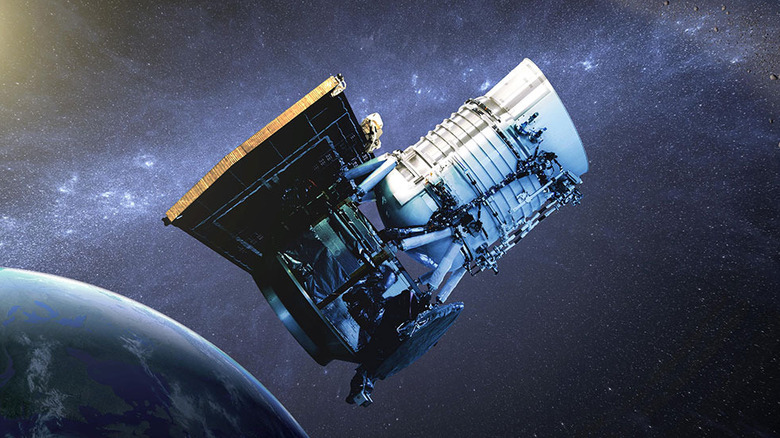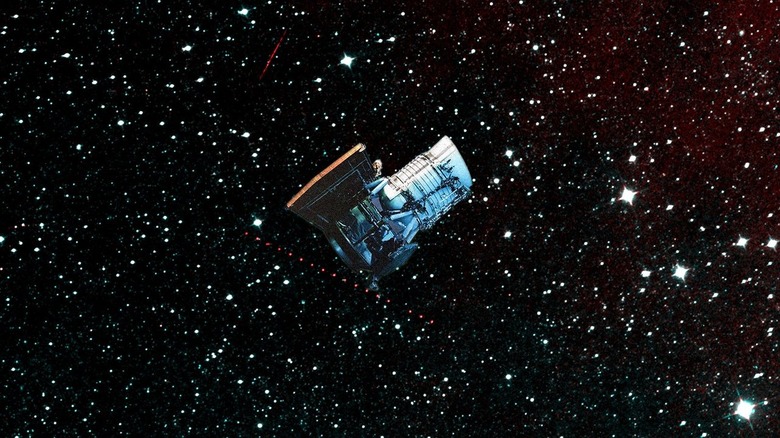Here's How NASA Spotted Thousands Of Near-Earth Asteroids
A NASA mission called NEOWISE will soon be coming to an end, but it leaves behind a legacy of 10 years of data observing the sky — during which time it spotted thousands of near-Earth asteroids. The spacecraft, called the Near-Earth Object Wide-field Infrared Survey Explorer, has been orbiting the Earth since its launch in 2009, but it only began asteroid hunting in 2014. In the last decade it has made 1.45 million infrared measurements of more than 44,000 solar system objects, according to NASA JPL.
NEOWISE was able to detect many asteroids because it operates in the infrared portion of the electromagnetic spectrum. Asteroids come in different colors, with some being lighter and others darker, depending on their composition and other factors. The lighter telescopes can be seen in the visible light wavelength (the same wavelength as human vision) but it's difficult to spot the darker ones in this wavelength. With infrared instruments, however, the asteroids can be detected by the heat they give off, so even the darker asteroids are visible.
In total, NEOWISE has observed more than 3,000 asteroids, of which 215 were discovered for the first time. By observing this many asteroids, the spacecraft could identify those whose orbits will bring them close to Earth's orbit — called near-earth objects (NEOs). This isn't to be confused with the ESA's NEOMIR mission, which is designed to spot NEOs that are "invisible" due to the sun.
How new solar system objects are discovered
While you might think of the solar system as basically just the planets and the sun, in fact it also includes hundreds of thousands of smaller objects like asteroids, comets, meteoroids, and minor planets out beyond the orbit of Neptune called trans-Neptunian objects. Most of these objects orbit the sun (though there are occasional visitors to our solar system from elsewhere, like the famous interstellar object 'Oumuamua), but not all of their orbits are circular. Many of them have elongated or elliptical orbits, meaning they may only come close to the inner solar system once in hundreds of years.
So if you look up into the sky and spot a faint object, it's hard to know what it is or where it came from. To accurately track that object, multiple observations are needed to find out how it is moving, and from this you can learn about its orbit and tell if it is a new detection or an already known object. Missions like NEOWISE can observe indications of an object moving across the sky, then these are compared with data from telescopes on the ground to tell if the object is new.
"The most fun thing when I look at the data for the first time is knowing that no one has seen this before. It puts you in a unique position of doing real exploration," said Roc Cutri, lead scientist for the NEOWISE Science Data System at Caltech's Infrared Processing and Analysis Center.
A second life for NEOWISE
The NEOWISE mission is expected to come to an end later this year, as it will fall out of orbit and burn up in the atmosphere. But it has already lived an extended life, as it was originally not designed for hunting asteroids at all. When it was launched in 2009, the spacecraft was known as the Wide-field Infrared Survey Explorer, or WISE. It was used to study more distant objects like far-off galaxies and red dwarf stars, as well as objects in the solar system.
The telescope's instruments need to be kept cold to operate, so it was launched with a supply of coolant. However, this coolant gets used up over time and was depleted by 2011, when the telescope's mission was thought to be over. It was put into hibernation until 2014, when NASA decided that it could still use the spacecraft's capabilities to observe the solar system and hunt for near-Earth objects.
The mission became NEOWISE in 2014 and has continued since then. What was originally intended to be a seven-month mission has ended up stretching over 14 years. Now, however, changes in the activity of the sun mean that the Earth's atmosphere is swelling and will create drag on the spacecraft, pulling it out of orbit. With no propellant on the spacecraft, there's no way to keep it in orbit so the mission will finally come to an end.

